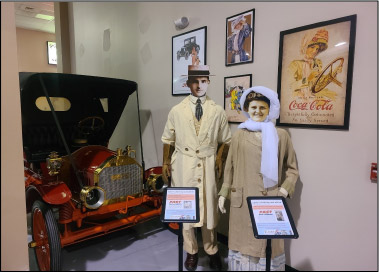The ever-intriguing 1955 Flajole Forerunner
Writing about Bill Flajole in Hemmings, Daniel Strohl once said, “William Flajole thought he knew exactly what people wanted to see in future cars in 1955. Then again, so did every other car nut with a pen in his hand … Flajole’s track record (the Nash Metropolitan, etc.) proved that, while his ability to think out of the box certainly remained strong, his prognostication abilities left much to be desired.” Still, the 1955 Flajole Forerunner remains the object of intrigue across the motoring landscape.
The Flajole Story: Mark Hyman of Hyman Ltd. Classic Cars generously donated the 1955 Flajole Forerunner to the AACA Museum, Inc. in 2012. Flajole’s prototype remains a favorite of the Museum’s collection. Hyman’s description provides a window into the Flajole story. The Forerunner is on display and is a part of our upcoming “Yeah! It’s got a Hemi!” exhibit.
Bill Flajole began his automobile design career right out of high school at Chrysler in 1933. He later moved to General Motors, and Ford where he worked with Bob Gregorie on the design of Edsel, Ford’s original Continental. Flajole designed a small Sportster, the Nash NXI, which eventually became the famous little Metropolitan.
Like many other designers of the early 1950s, he was fascinated by the Jaguar XK120. He began sketching his own ideas as applied to the XK’s 102-inch wheelbase, six-cylinder dual overhead camshaft engine, and low slung chassis. The Flajole Forerunner is the embodiment of those ideas.”
Created in fiberglass in Flajole’s studio, the Forerunner sported tall fenders with a dropped hood, a wide grille integrated with the bumpers, and an innovative retractable roof that slid down to hide under a dramatically sloping fastback rear deck. Its final iteration included an innovative translucent roof panel and had dramatic recessed cove panels behind the wheels, design features that foreshadowed Corvette’s adoption of them in 1956. The interior incorporates supportive aircraft-type seats with head restraints, years before other designers appreciated the value of supportive seats in minimizing accident injuries.
Bill Flajole used the car for his personal transportation until the early 1970s. It was restored in its present dramatic metallic purple with white coves, matching white and purple leather upholstery, and chrome wire wheels.
Featured Image: Mechanix Illustrated Issue: Sep, 1955 (Modern Mechanix)



















